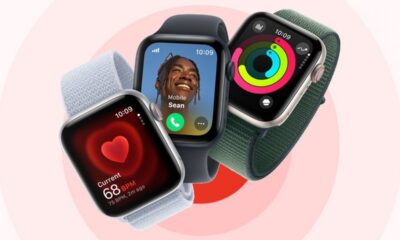Reviews
AI Features Present in Your Apple Watch

While the buzz around generative AI may be relatively recent for Apple, the incorporation of AI-powered algorithms has long been a cornerstone across its products, including the beloved Apple Watch. Through a seamless integration of sensors and machine learning, the Apple Watch delivers a suite of health and wellness features that provide users with invaluable insights throughout the day.
When notifications pop up on your Apple Watch—whether it’s a gentle reminder to take a breath, a prompt to stand up, or alerts about potentially harmful noise levels—these nudges are powered by AI algorithms analyzing data from the device’s built-in sensors. This fusion of technology results in an Apple Watch experience that not only monitors health and fitness but also offers personalized wellness guidance.
Behind the scenes, Apple harnesses a multitude of sensors embedded within the Apple Watch to gather a wealth of health data. This data is then processed through machine learning and AI models to create a tailored user experience. From simple algorithms to advanced generative AI—similar to those underpinning services like ChatGPT and DALL-E—Apple employs a spectrum of AI implementations to enhance its products.
While speculation abounds regarding the rumored Apple Watch X, set to commemorate ten years since the original’s debut in 2014, the specifics of its AI innovations remain a mystery. However, users need not wait for new releases to experience AI on their wrists. Here are some notable AI-driven features available on recent Apple Watch models:
Double Tap
Introduced with the Apple Watch Series 9 and Watch Ultra 2, the Double Tap feature enables hands-free interaction with the device. By tapping your index finger and thumb together twice, users can execute various functions such as answering calls, snoozing alarms, and even capturing photos. Powered by the new S9 chip and machine learning, this feature detects subtle finger movements and changes in blood flow to activate the relevant functions.
Native Sleep Tracking
Using AI algorithms, the Apple Watch tracks sleep patterns by analyzing movements and heart rate fluctuations throughout the night. Leveraging data from sensors, the device distinguishes between different sleep stages—REM, Core, deep sleep, and wakefulness—aided by on-device machine learning for accurate classification.
Fall Detection
Employing accelerometers and gyroscopes, the Apple Watch can detect sudden falls and prompt emergency calls if necessary. By analyzing impact force and wrist movements, AI algorithms enable the device to recognize falls and initiate appropriate responses, including emergency service alerts.
Irregular Heartbeat Detection
With sensors capable of monitoring heart rhythms, the Apple Watch can detect irregularities such as atrial fibrillation (AFib), a common cause of strokes. By continuously analyzing data from the heart rate sensor, AI algorithms can identify irregular heart rhythms and trigger alerts like the Irregular Rhythm Notification Feature, potentially alerting users to undiagnosed conditions.
In essence, the Apple Watch seamlessly integrates AI technologies to provide users with actionable insights and personalized experiences, reaffirming Apple’s commitment to innovation in health and wellness.












